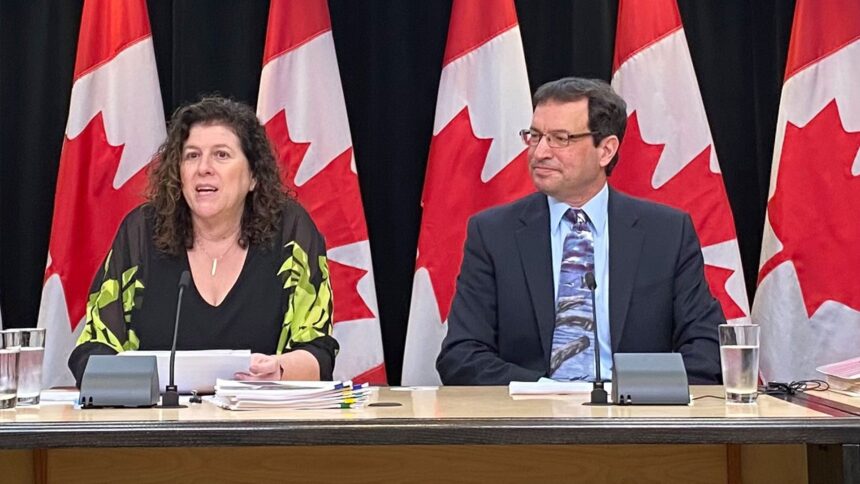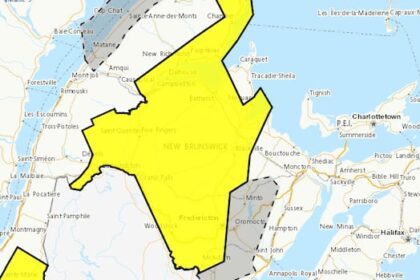The Auditor General of Canada is set to release a report that looks at six audits related to Indigenous issues from the past. Karen Hogan’s report will examine how the government has progressed on First Nations’ access to health, oral health, education, drinking water, health resources and emergency management. The auditor general’s office conducts investigations into government programs to ensure that they’re being run according to federal guidelines and within budget. In most of the reports in the past, Hogan’s office has found that the federal government has floundered in trying to provide services to First Nation, Inuit and Métis communities. Hogan’s report will go back as far as 2015 when the AG looked at access to health care for remote First Nation communities. Here’s an edited look at the six audits that will be reviewed. For more, click on each title to review the full audit. Access to Health Services for Remote First Nations Communities (2015) According to the auditor general, the audit focused on whether Health Canada had “reasonable assurance that eligible First Nations individuals living in remote communities in Manitoba and Ontario had access to clinical and client care services, and medical transportation benefits.” The main focus of the audit was on nursing. The AG said in 2015 that the audit didn’t cover the “quality of health services and benefits provided, or the adequacy of federal resources spent on supporting First Nations individuals’ access to health services and benefits.” Nursing – overall findings The auditor general found that nurses working in remote communities were properly registered – but that only one in 45 nurses looked at “had completed all five of Health Canada’s mandatory training courses that we selected for examination.” According to the AG, this issue was also covered in a 2010 internal audit at Health Canada. “We are concerned that this issue persists and that it could negatively affect the health services provided to First Nations individuals,” the AG wrote in the 2015 report. The AG also found that Health Canada had “identified numerous deficiencies in nursing stations related to health and safety requirements or building codes.” The auditor general said at a nursing station that was visited, the building had been “unusable for more than two years because the septic system had not been repaired. Consequently, health specialists cancelled their visits to the community.” “Lastly, we found that Health Canada had recently defined essential health services that should be provided in nursing stations. However, the Department had not assessed whether each nursing station had the capacity to provide these services, nor had it informed First Nations individuals what essential services were provided at the station.” Recommendation. Health Canada should ensure that its nurses working in remote First Nations communities successfully complete the mandatory training courses specified by the Department. The Department’s response. Agreed. Health Canada recognizes that training is very important. Going forward, the Department will strengthen its efforts to meet mandatory training for its nurses and establish processes to monitor compliance and completion rates. One of the challenges in meeting these requirements has been the significant vacancy and turnover rates in nursing. The first order of priority has been to assign adequate levels of nurses in all nursing stations. Health Canada’s Nurse Recruitment and Retention Strategy (October 2013) is striving to augment and stabilize its nursing workforce in efforts to address these shortages. Health Canada will work to balance training needs and service to communities, ensuring that training does not result in a loss of services in a community. Recommendation. Health Canada should ensure that its nurses are provided with appropriate supporting mechanisms that allow them to provide essential health services that are outside their legislated scope of practice. The Department’s response. Agreed. Health Canada agrees that nurses need appropriate supporting mechanisms to perform their important duties, and a number of mechanisms are already in place. Health Canada will continue to strengthen and formalize its management and risk control framework for clinical care. Recommendation. Health Canada should work with First Nations communities to ensure that nursing stations are inspected on a regular basis and that deficiencies related to health and safety requirements or building codes are addressed in a timely manner. The Department’s response. Agreed. Health Canada will continue to work with First Nations to ensure that buildings are inspected on a regular basis and that deficiencies are addressed in a timely manner. In particular, Health Canada will standardize procedures to ensure facility condition reports are systematically shared with building owners. Recommendation. Health Canada should work with First Nations communities to ensure that new nursing stations are built according to applicable building codes. The Department’s response. Agreed. Ensuring buildings are to code is a priority for Health Canada. The Department has a long-standing process that requires an attestation by an architect or engineer to provide assurance that the construction is completed and is compliant with the applicable building codes. Recommendation. Health Canada should work with First Nations communities to ensure that nursing stations are capable of providing Health Canada’s essential health services. The Department’s response. Agreed. Allocating nursing resources to support the safe, supportive, and culturally appropriate delivery of health services is a priority for Health Canada. In collaboration with First Nations, Health Canada will review the clinical care complement in an effort to progressively move toward the creation of interprofessional teams where possible to support the culturally appropriate, safe, and effective delivery of essential services. Recommendation. Health Canada should work with First Nations communities to communicate what services each nursing station provides. The Department’s response. Agreed. Health Canada, in collaboration with First Nations, will provide a list of all clinical care services offered at each nursing station for communication to community members. Recommendation. Health Canada should work with First Nations communities to ensure that nursing stations are capable of providing Health Canada’s essential health services. The Department’s response. Agreed. Allocating nursing resources to support the safe, supportive, and culturally appropriate delivery of health services is a priority for Health Canada. In collaboration with First Nations, Health Canada will review the clinical care complement in an effort to progressively move toward the creation of interprofessional teams where possible to support the culturally appropriate, safe, and effective delivery of essential services. Recommendation. Health Canada should work with First Nations communities to communicate what services each nursing station provides. The Department’s response. Agreed. Health Canada, in collaboration with First Nations, will provide a list of all clinical care services offered at each nursing station for communication to community members. Medical transport The AG found that “Health Canada’s medical transportation benefits were available to registered First Nations individuals but that individuals over one year old and not registered in the Indian Registration System may be denied access to these benefits.” Recommendation. Health Canada should work with First Nations communities, and Aboriginal Affairs and Northern Development Canada, to facilitate the registration of First Nations individuals. The Department’s response. Agreed. Health Canada will ensure that information materials about the Indian registration process are available in all nursing stations and will continue to work with partners to improve the availability of information in health facilities. Recommendation. Health Canada should maintain sufficient documentation to comply with the Treasury Board’s 2009 Directive on Recordkeeping and to demonstrate that medical transportation benefits are administered according to Health Canada’s 2005 Medical Transportation Policy Framework. The Department’s response. Agreed. Health Canada’s goal is to ensure that eligible clients receive timely coverage for medical transportation benefits in accordance with the provision of the 2005 Medical Transportation Policy Framework. At the same time, the Department is making efforts to adapt its processes to avoid undue burden on clients and health care professionals. Recommendation. When allocating nursing staff levels and other support, Health Canada should work with First Nations communities, and take into account their health needs. The Department’s response. Agreed. Health Canada will work with First Nations communities to better integrate clinical care with culturally appropriate community health planning. This will ensure that Health Canada’s services are further aligned with other health services under the control of the First Nations community. Health Canada is funding a number of community-based programs that aim to respond to community needs in the areas of mental health, maternal and child health, public health, and home and community care in addition to clinical care. Recommendation. Health Canada should work with First Nations communities, provinces, and health service providers to ensure that First Nations individuals living in remote communities have comparable access to clinical and client care services as other provincial residents living in similar geographic locations. The Department’s response. Agreed. Health Canada’s priority is to support First Nations communities in receiving health services and benefits that are responsive to their needs and improve their health status. Health Canada will work with First Nations communities to build health service delivery models for remote and isolated communities. Oral Health Programs for First Nations and Inuit (2017) ‘Despite knowing for many years about the poor oral health of Inuit and First Nations people, the Department had never finalized a strategic approach to help improve it,’ says the auditor general. Photo: APTN. The focus of this 2017 audit was on whether Health Canada understood that its oral health program for First Nations and Inuit who were eligible was having a positive effect. According to the report, the AG found that Health Canada, overall, monitored and analyzed the dental benefits from the Non-Insured Health Benefits Program. But, the auditor general said, despite the monitoring, “the Department did not know how much of a difference it was making to Inuit and First Nations people’s oral health.” “Despite knowing for many years about the poor oral health of Inuit and First Nations people, the Department had never finalized a strategic approach to help improve it,” the AG said. The program delivered by Health Canada called the Children’s Oral Health Initiative, “focused on prevention and helped some First Nations and Inuit children improve their oral health.” “However, departmental data indicated that both enrolment in the initiative and the number of services it delivered had declined. The Department did not know why,” the AG said. “These findings matter because Inuit and First Nations people have more unmet oral health needs than the rest of Canadians do,” said the report. “The Department spends more than $200 million per year on oral health services for these populations; a strategy would provide Health Canada with direction on how to meet their needs and help them to improve their oral health. “Knowing what difference the programs are making would also help the Department find opportunities to improve the programs’ effect on oral health.” Recommendation. Health Canada should finalize and implement a strategic approach to oral health for Inuit and First Nations people, along with a detailed action plan with specific timelines, and monitor implementation. The Department’s response. Agreed. Health Canada has already developed oral health service delivery plans to guide the delivery of oral health programs in each region. The expansion of the Children’s Oral Health Initiative, announced in Budget 2017, is currently the subject of planning discussions with First Nations and Inuit partners in all regions. Recommendation. Health Canada should develop a concrete plan to determine how much of a difference its oral health services are making on the oral health of Inuit and First Nations people. This plan should use all the relevant information the Department collects, and should include a collaboration among all of Health Canada’s programs involved in oral health. The Department’s response. Agreed. Health Canada agrees that understanding the impact of these programs on the oral health of First Nations and Inuit is important, and will continue to work with its partner organizations towards the goal of completing the population-level oral health surveys. Health Canada has well-established processes and methodologies in place to monitor the data it collects, and will engage the Non-Insured Health Benefits Oral Health Advisory Committee to provide advice on the First Nations and Inuit Health Branch’s approach to analyzing all the relevant information it collects. Recommendation. Health Canada should improve its analysis of data, including the information that is collected and recorded in its dental database, so that its information on the Children’s Oral Health Initiative is accurate and comprehensive enough to contribute to the Department’s overall management of its oral health programs. The Department’s response. Agreed. Health Canada will continue to improve its data analysis by implementing the Strategies to Improve Oral Health Data Collection, Analysis, and Reporting for First Nations and Inuit Health Branch’s dental programs to inform program management decision making in alignment with the Oral Health Integrated Approach. Recommendation. Health Canada’s process for making changes to its list of oral health services covered by the Non-Insured Health Benefits Program should include which elements should be considered, include requirements to document when and how decisions are made, specify who has final approval for all such decisions, and include quickly updating providers and clients on changes. (4.53–4.62) The Department’s response. Agreed. Health Canada has detailed documentation in place, such as its Dental Benefits Policy Framework: Non-Insured Health Benefits Program and evidence-based guidelines, to govern decision making related to dental benefits. One of these documents—the Policy Review and Development Process for Dental Benefits—has been revised in light of the findings of this audit to be more specific about the elements that must be considered when making policy changes. Additionally, the Non-Insured Health Benefits Program will adapt the process for updating clients and service providers of changes in a timely manner. Recommendation. To improve its program management for the Non-Insured Health Benefits Program dental benefit, Health Canada should clarify what its service standard for pre-approvals is measuring; clarify the service standard for complex appeals; and improve its data entry, so that it has accurate and reliable information in its appeal database. The Department’s response. Agreed. Health Canada will review its program management processes and will develop communications for clients, partners, and providers regarding its timelines for reviewing predeterminations and appeals. Furthermore, the Department will continue to improve data entry accuracy pertaining to its administrative appeals database. The procurement process for the new Health Information and Claims Processing Services system is looking to integrate the appeals process within this system. Recommendation. Health Canada should implement strategies to ensure that it has the human resources it needs to deliver oral health programs and related services to First Nations and Inuit populations over the long term. These strategies could incorporate the use of a variety of professionals and adopt practices from other regions, where applicable. The Department’s response. Agreed. Health Canada relies on a variety of oral health professionals (such as dentists, dental hygienists, and dental therapists) to provide access to oral health services for its clients and continues to work with partners and stakeholders to increase oral health provider enrolment. Health Canada will ensure that foreseeable shortages are addressed through contingency plans developed by regions facing such a challenge. Socio-Economic Gaps on First Nations Reserves (2018) Stein Valley School Nlakapamux School. The 2018 audit measured whether Indigenous Services Canada “satisfactorily measured and reported” on Canada’s progress in closing in closing the “socio-economic gaps” between on-reserve First Nations people and people living off-reserve. According to the AG, the report also focused on whether ISC “ made adequate use of data to improve education programs to close the education gap and improve socio-economic well-being.” Its “overall message” was that ISC’s collection of information on community well-being of First Nations people living on reserve, “was not comprehensive.” “While the index included Statistics Canada data on education, employment, income, and housing, it omitted several aspects of well-being that are also important to First Nations people—such as health, environment, language, and culture,” said the auditor general. “We also found that the Department did not adequately use the large amount of program data provided by First Nations, nor did it adequately use other available data and information. The Department also did not meaningfully engage with First Nations to satisfactorily measure and report on whether the lives of people on First Nations reserves were improving. For example, the Department did not adequately measure and report on the education gap. In fact, our calculations showed that this gap had widened in the past 15 years.” The AG said getting the information correct is important because it helps everyone – Parliamentarians, First Nations and others to better understand the issue. Recommendation. Through engagement with First Nations and other partners, Indigenous Services Canada should use relevant data to comprehensively measure and report on the overall socio-economic well-being of First Nations people on reserves compared with that of other Canadians. The Department should also measure and report on those additional aspects of socio-economic well-being that First Nations have identified as unique priorities, such as language and culture, which might not be directly comparable with other Canadians. The Department’s response. Agreed. Indigenous Services Canada will build on the Community Well-Being index by co-developing, with First Nations and other partners, a broad dashboard of well-being outcomes that will reflect mutually agreed-upon metrics in measuring and reporting on closing socio-economic gaps. Much of this work is already under way with the Assembly of First Nations and other partners in the co-development of a new fiscal relationship. Recommendation. Through engagement with First Nations and other partners, Indigenous Services Canada should collect, use, and share data with First Nations appropriately to improve education results of First Nations people on reserves. The Department’s response. Agreed. Indigenous Services Canada has invested in relationships with First Nations to manage data related to education, including ongoing collaboration to identify meaningful education results that would replace the current approach. These renewed education goals, together with agreed-upon measures and a data collection strategy, will be developed as part of the upcoming education transformation for elementary, secondary, and post-secondary education. In the meantime, the Department is actively exchanging data with First Nations to support education transformation. Reporting on First Nations’ education results Recommendation. Indigenous Services Canada’s reporting on First Nations’ education results should be complete and accurate. The Department’s response. Agreed. Indigenous Services Canada is actively working with First Nations to transform elementary and secondary education, and will be co-developing renewed education outcomes, measurements, and a related data strategy. Likewise, the Department is working with First Nations and other Indigenous partners to transform post-secondary education. Embedded in the approach to renewed education will be agreement on mutual accountability and practices promoting complete and accurate reporting. Access to Safe Drinking Water in First Nations Communities (2021) A sign posted in Neskantaga outlining the feelings of the community. Photo: Media pool. One of the big promises from the 2015 federal Liberal campaign was to end water advisories in First Nations. It was during the campaign that Neskantaga First Nation in northern Ontario was cast into the spotlight for having the longest water advisory in the country. At the time, the Liberals, under then leader Justin Trudeau, promised to eliminate all water advisories by 2021. Ten years after that promise, the community still doesn’t have clean water. In its 2021 audit, six years after the Liberals won the election, the auditor general’s office focused on whether ISC provided “adequate support to First Nations communities to ensure that they have access to safe drinking water.” “We examined the department’s progress against the federal government’s commitment to eliminate all long-term drinking water advisories on public water systems on First Nations reserves by 31 March 2021,” the AG said. “We also examined whether the department determined and provided the amount of funding necessary to operate and maintain drinking water infrastructure and whether, in collaboration with First Nations, the department made progress in developing a regulatory regime for drinking water in First Nations communities.” The AG said, “overall, Indigenous Services Canada did not provide the support necessary to ensure that First Nations communities have ongoing access to safe drinking water. Drinking water advisories remained a constant for many communities, with almost half of the existing advisories in place for more than a decade.” One of the issues was that there was no “regulatory regime” in place to manage drinking water issues in First Nations, the AG said. Indigenous Services Canada was working with First Nations to develop a new legislative framework with the goal of supporting the development of a regulatory regime,” the AG said, “Such a regime would provide First Nations communities with drinking water protections comparable with other communities in Canada.” Note: In 2023, the Liberals introduced Bill C-61, the First Nations Clean Drinking Water Act. The proposed law had broad support in the House of Commons. But progress on Bill C-61 ended when former prime minister Justin Trudeau prorogued Parliament on Jan. 6. The current Liberal government said it would reintroduce the bill in the fall. APTN News has been checking in regularly with the office of ISC Minister Mandy Gull-Masty as to when the new legislation will be introduced. We’re told there is no time table. Recommendation. Indigenous Services Canada should work with First Nations communities to strengthen efforts to eliminate all long-term drinking water advisories and prevent new ones from occurring. The department’s response. Agreed. In the Fall Economic Statement 2020, the Government of Canada committed an additional $309 million to continue the work to address all remaining long-term drinking water advisories as soon as possible. Indigenous Services Canada will continue to actively work with First Nations to address drinking water issues, including by assessing the impact of the coronavirus disease (COVID-19) pandemic on timelines and supporting the advancement of projects in a way that respects public health measures. The department will continue to advocate for a continuation of program funding with central agencies to ensure continued support for water and wastewater services in First Nations with the objective of obtaining long-term stable funding. Recommendation. Indigenous Services Canada should work with First Nations communities to implement long-term solutions to ensure that water systems in First Nations communities provide ongoing access to safe drinking water. The department’s response. Agreed. Working with First Nations, Indigenous Services Canada will continue to support long-term measures to ensure that First Nations have ongoing access to safe drinking water. Recommendation. Indigenous Services Canada should work with First Nations to proactively identify and address underlying deficiencies in water systems to prevent recurring advisories. The department’s response. Agreed. Indigenous Services Canada will continue to work with First Nations to conduct performance inspections of water systems annually and asset condition assessments every 3 years to identify deficiencies. The department will proactively work with communities to address those deficiencies and prevent recurring advisories. Recommendation. Indigenous Services Canada, in consultation with First Nations, should make it a priority to identify the amount of funding needed by First Nations to operate and maintain drinking water infrastructure. The department’s response. Agreed. Indigenous Services Canada will continue to work with First Nations partners to ensure that sufficient water and wastewater operations and maintenance funding is provided and to amend associated policies. Recommendation. Indigenous Services Canada, in consultation with First Nations, should develop and implement a regulatory regime for safe drinking water in First Nations communities. The department’s response. Agreed. Indigenous Services Canada will continue to support the Assembly of First Nations in its lead role in the engagement process. The department will continue to work collaboratively and in full partnership with the Assembly of First Nations, other First Nations and First Nations organizations, and other federal departments to develop a legislative framework that can be presented to Cabinet. Health Resources for Indigenous Communities (2021) The auditor general found that ISC ‘adapted quickly’ to the need for personal protective equipment. Photo: APTN. The COVID-19 pandemic forced governments to scramble for protective equipment for the public and health professionals working at the heart of the crisis. In 2021, the auditor general focused on Indigenous Services Canada and whether it provided “sufficient personal protective equipment (PPE), nurses, and paramedics to Indigenous communities and organizations in a coordinated and timely manner,” to help Indigenous people manage the pandemic. The AG said it also examined whether ISC “maintained a sufficient stockpile of PPE” and whether it “coordinated with other federal organizations, provincial and territorial governments, and Indigenous governments and organizations to provide PPE, nurses, and paramedics to Indigenous communities and organizations.” “Overall, although we found weaknesses in Indigenous Services Canada’s management of its personal protective equipment (PPE) stockpile, the department adapted quickly to respond to the COVID‑19 pandemic,” the AG report said. “The department expanded access to its PPE stockpile to health care workers in Indigenous communities and organizations when provinces and territories were unable to provide PPE. It also expanded access to its stockpile to additional individuals supporting the delivery of health services, such as community-based water monitors and police officers, as well as people in communities who were sick with COVID‑19 or taking care of a sick family member. The department’s support helped Indigenous communities and organizations respond to the pandemic.” The AG also noted that, “Indigenous Services Canada streamlined its processes for hiring nurses in remote or isolated First Nations communities and also made its contract nurses and paramedics available to all Indigenous communities to respond to the additional health care needs caused by COVID‑19. “Despite this, the department was unable to meet more than half of the requests for extra contract nurses and paramedics needed to respond to COVID‑19.” Recommendation. Indigenous Services Canada should review the management of its personal protective equipment stockpile to ensure that it has accurate records and the right amount of stock to respond to the current pandemic and future public health emergencies faced by Indigenous communities and organizations. The department’s response. Agreed. Indigenous Services Canada reviewed its initial inventory of personal protective equipment (PPE) from before the COVID‑19 pandemic and compared it with the average burn rate for PPE for the first year of the pandemic. To ensure that Indigenous Services Canada has accurate records and the optimum amount of stock to respond to the current and future public health emergencies, the department has completed the first phase of an automated inventory management tool. The department will continue to identify and maintain optimum amounts of PPE in its stockpile for the needs of First Nations people living on reserve to respond to public health emergencies. It will continue to work with provincial, territorial, and federal partners in identifying the optimum amounts of PPE to protect Indigenous peoples. Nurses and paramedics Recommendation. Indigenous Services Canada should work with the 51 remote or isolated First Nations communities to consider other approaches to address the ongoing shortage of nurses in these communities and to review the nursing and paramedic support provided to all Indigenous communities to identify best practices. The department’s response. Agreed. Indigenous Services Canada agrees with collaborating with the 51 First Nations communities it directly serves in developing approaches to addressing staff shortages, including the health-human-resource complement and best-practice models for the community. Emergency Management in First Nations Communities (2022) A RCAF Hercules in Norway House Cree Nation in Manitoba on May 29. Photo courtesy: Tobi Wilson. Given the situation with wildfires, floods and severe weather, communities across the country will likely have an interest in this audit. According to the AG, the 2022 audit focused on whether Indigenous Services Canada “provided the emergency management support needed by First Nations communities.” “We examined the department’s activities related to floods, wildfires, landslides, and severe weather events because these are the most prevalent types of emergencies affecting First Nations communities,” the AG said in 2022. “Our audit looked at First Nations communities in the provinces and not in the territories because almost all on‑reserve First Nations communities are located in the provinces. The AG’s overall message was that ISC “did not provide the support First Nations communities needed to manage emergencies such as floods and wildfires, which are happening more often and with greater intensity.” “We found that the department’s actions were more reactive than preventative, despite First Nations communities identifying many infrastructure projects to mitigate the impact of emergencies. The department had a backlog of 112 of these infrastructure projects that it had determined were eligible but that it had not funded. “The department is also spending 3.5 times more money on responding to and recovering from emergencies than on supporting the communities to prevent or prepare for them. Until these projects are completed, First Nations communities are likely to continue to experience emergencies that could be averted by investing in the right infrastructure. “Many issues have not improved since we first identified them in our 2013 audit of emergency management on reserves. For example, Indigenous Services Canada still had not identified which First Nations communities were the least likely to be able to manage emergencies. Doing so would allow the department to target investments in these communities, such as building culverts and dikes to prevent seasonal floods, and to help avoid some of the costs of responding to and recovering from emergencies. “The department also did not know whether First Nations received services that were culturally appropriate and comparable to emergency services provided in municipalities of similar size and circumstance because it did not identify or consistently monitor the services or level of services to be provided to First Nations. Recommendation. Indigenous Services Canada should work with First Nations to implement a risk-based approach to inform program planning and decisions on where to invest in preparedness and mitigation activities to maximize support to communities at highest risk of being affected by emergencies. The department’s response. Agreed. In collaboration with First Nations, Indigenous Services Canada is committed to implement a risk-based approach to inform funding decisions. Targeted investments by the department will consider, as it has to date, the communities’ willingness, readiness and interest in undertaking emergency preparedness activities by empowering First Nations to take the lead in preparing for and managing emergencies. Recommendation. Indigenous Services Canada should work with First Nations communities to address the backlogs of eligible but unfunded structural mitigation projects and of unreviewed structural mitigation projects to effectively allocate resources to reduce the impact of emergencies on First Nations communities. The department’s response. Agreed. Indigenous Services Canada is currently working with First Nations to identify the infrastructure gap, which includes structural mitigation needs. The department will support First Nations to work toward closing that gap in the long term. Recommendation. Indigenous Services Canada should, on the basis of an assessment of risks, regularly update outdated departmental and regional emergency management plans and take immediate action to develop regional emergency management plans for the 3 regions that do not have them. These plans should be used to make informed decisions and take concrete actions to assist First Nations communities with managing the risks related to emergencies. The department’s response. Agreed. Indigenous Services Canada, in collaboration with First Nations, will proceed to review and update the department’s national Emergency Management Plan and regional plans and will develop customized regional emergency management plans based on an assessment of risks. Recommendation. Indigenous Services Canada, in collaboration with First Nations, should determine how many emergency management coordinator positions are required and allocate funding for these positions on the basis of risk and need to ensure that First Nations have sustained capacity to manage emergencies. The department’s response. Agreed. Indigenous Services Canada is committed to work in partnership with First Nations to build emergency management capacity. The department also agrees that funding for emergency management positions, provided through the Emergency Management Assistance Program’s capacity enhancement funding stream, should be expanded. Emergency management coordinators, of which the department currently funds 196 full- or part-time positions across the country, provide First Nations with valuable emergency preparedness and planning capacity. Recommendation. Indigenous Services Canada should, in collaboration with First Nations, provincial governments, and other service providers, ensure that First Nations communities receive the emergency management services they need by: establishing emergency management service agreements and wildfire agreements in all jurisdictions that include all First Nations; establishing mutually agreed-upon evacuation service standards in the jurisdictions that lack such standards and increasing support for First Nations–led approaches to emergency management. The department’s response. Agreed. Indigenous Services Canada is committed to work in partnership with First Nations and emergency management partners to establish comprehensive emergency management service agreements. Recommendation. Indigenous Services Canada should develop performance indicators to allow the department to measure progress against the United Nations’ Sustainable Development Goals and use these indicators to track and report publicly on progress. Indigenous Services Canada should, in collaboration with First Nations, provincial governments, and other service providers, ensure that First Nations communities receive the emergency management services they need by defining what is meant by comparable services for First Nations in relation to those available to municipalities of similar size and circumstance in each jurisdiction monitoring the services provided to First Nations to ensure that they are comparable to services provided to non‑Indigenous communities, are culturally appropriate, and address the needs of marginalized groups identifying and addressing shortcomings by monitoring emergency management service agreements and conducting lessons-learned exercises The department’s response. Agreed. Indigenous Services Canada agrees that certain performance indicators could be improved to better measure progress against the United Nations’ Sustainable Development Goals. Moving forward, the department will ask its programs that use performance indicators related to emergency management to review and consider revising how they measure progress against the Sustainable Development Goals. Recommendation. Indigenous Services Canada should, in collaboration with First Nations, provincial governments, and other service providers, ensure that First Nations communities receive the emergency management services they need by defining what is meant by comparable services for First Nations in relation to those available to municipalities of similar size and circumstance in each jurisdiction monitoring the services provided to First Nations to ensure that they are comparable to services provided to non‑Indigenous communities, are culturally appropriate, and address the needs of marginalized groups identifying and addressing shortcomings by monitoring emergency management service agreements and conducting lessons-learned exercises. The department’s response. Agreed. Indigenous Services Canada is committed to work in partnership with First Nations and emergency management partners to establish comprehensive emergency management service agreements that will define comparability of services and monitoring and reporting components to identify and address shortcomings for continuous improvement. Continue Reading
Auditor General set to release updates on 6 past audits. Heres what the AG is looking at

Leave a Comment









